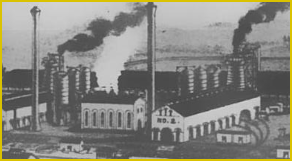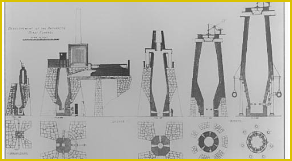












Last Gasps
Paranormal



The South’s science-based team!
Our trained investigators are here to believe you. Most importantly, we are here to solve the problem...no matter what it takes. Our services are always FREE.

© 2023 Last Gasps paranormal. Links | Terms and Conditions







Sloss Furnace
Birmingham, AL


In September 2013, Chief Investigator KyL Cobb participated with another team in an investigation of the Sloss Furnace. The history research for this location was created to prepare for this investigation.
Written by Kyle T. Cobb, Jr.
Nos tibi credere.
Haunted Places
History
Colonel James Withers Sloss started Sloss Furnace in 22 March 1881 and in June 1881 construction began on the first blast furnace on 50 acres.
A key part of the plants early design was the use of two Whitwell-type furnaces that were 60 feet (18 m) tall and 18 feet (5.4 m) in diameter. The first blast was initiated in April 1882. The facility produced 24,000 tons of high quality iron during its first year of operation. The furnaces completely rebuilt with modern equipment between 1927 and 1931. At that time, the charging and casting machinery were also replaced.
The oldest remaining building at the site was used to house the 1902, 1906 and 1914 “blowing-engines” The two blowers were steam-driven, weighed 85-tons had 84 inch cylinders. In 1949 and 1951, the company replaced the old blowing engines with two-turbo blowers. The 10 original boilers were 30 feet long and had a 46 inch diameter. The boilers, installed in 1906 and 1914, produced steam for the site until it closed in 1970.
Sloss was more than just an industrial site. It provided an opportunity for black men to have a high-paying, color blind (though dangerous) job. According to first hand reports, working at Sloss was not a bad job. Alonzo Gaines was a Laborer/Stove tender during his tenure from 1925 to 1940. As a black worker in the South, Gaines experienced some extreme working conditions. Born in 1906, on a farm in Athens, Georgia, Gaines was exposed to racism from a young age.“They always called us niggers, not blacks, but that didn’t bother me much, because for me working at Sloss Furnaces was a great opportunity,” said Gaines. Like many other blacks at the time flooded into factories where the conditions for blacks were good in industrial Birmingham. Sloss Furnaces was a popular place for many African Americans like Gaines. Although many blacks found that there was money to be made at Sloss Furnaces, outside the factory gates they were confronted with a segregated, Jim Crow society. As Birmingham historian, Bobby M. Wilson notes, “Sloss furnaces, like other large corporations in Birmingham, were unique in how they gave blacks a chance to improve their status in the workplace.” But Wilson goes on to pinpoint the difficulties of translating that status to the wider community.
Gaines stated, “I used to look forward to going to work, because I could work beside a white man and he would talk to me like I was a man instead of an animal.” For this reason blacks sought security in such industries as Sloss.
In an effort to support the factory, 48 small cottages for black workers were built near the downtown furnace. The community became known as "Sloss Quarters" or just "the quarters". A company store was also established to support the workers.
In 1886, Sloss retired and sold the company to a group of investors who reorganized it in 1899 as the Sloss-Sheffield Steel and Iron Company. For the next 90 years, the furnace operated to varying degrees under a variety of different owners. While the demand for “pig iron” gave way to the demand for steel, the Furnaces continued in a diminished capacity. During World War II, the dehumidification plant was to reduce consumption of coke. Following the war the two slag granulators were used to produce the “expanded slag” needed to make structural concrete, mineral wool and other products.
Finally, the Jim Walter Company closed the furnaces 1971.
About two-thirds of the historic structures on the site were stabilized using the bond funds approved by Birmingham voters in 1977. In 1981 the Furnace was designated a National Historic Landmark. In September 1983, a museum was opened on the location.
In 2009, Sloss became the new home of the SLSF 4018 steam locomotive, which was relocated from Birmingham's Fair Park.
Deaths
Approximately 60 deaths are recorded at the Sloss furnace site. 47 are rumored to be related to Wormwood…
James Robert “Slag” Wormwood, plant manager from 1886 until death in October 1899. Supervised 150 workers. Legend says Woodworm died during his only inspection of the top of the tallest furnace tower where Wormwood fell from catwalk into molten ore. Wormwood’s death ended nighttime work at plant.
Story of Woodworm is fiction based on death of well-liked assistant foundryman Richard Jowers who died at Debardeleben Coal and Iron Company’s Alice #1 Furnace, not Sloss, at the other side of Birmingham on 9 September 1887. Jowers allegedly fell into the furnace while supervising the repair of the melting bell (a kind of funnel). The original Wormwood haunting’s as well as his death are first recorded at Alice Furnace #1 but when it was decommissioned and destroyed in 1905, the legend shifted to Alice #2 until its demolition in 1927. The ghost moved across town to Sloss after that. Most of the Wormwood legend is from the haunted house at the Sloss location. Additional confusion is linked to the 1978 book The Ghost in the Sloss Furnaces by Kathryn Tucker Windham that uses the fictional name of Theophilus Calvin Jowers.
One of the first accidents from book, Sloss Furnaces and the Rise of the Birmingham District: An Industrial Epic by author Walter David Lewis. In November 1882, two black laborers by the names of Aleck King and Bob May were tasked with removing ore and coke that has burned to the brick walls of the Number One furnace. The two men were lowered into the interior of the furnace and began to dislodge the material, which felt into the materials in the hearth that were still smoldering. The resulting smoke and gas quickly overcame the men and they fell to their deaths. The book goes on to report that a crowd quickly assembled to gape at the men's burned remains. The deaths of Aleck King and Bob May are part of the folklore of the Sloss Furnaces to this day, though their names are generally left out of most accounts. The story is most often associated with Furnace Number One on the site today, although this might not be entirely accurate. According to that Historic Landmark's official site, the Number One furnace that took their lives was part of the original furnace complex, which has since been replaced. In fact, the oldest building in the complex dates back to 1902, which did not exist until twenty years after the accident. It is entirely possible that scraps or parts of the original structure were used in the construction of the new Furnace Number One, but this has been unverified.
The same week in November 1882 Samuel Cunningham committed suicide at Alice #1 by ascending the hoist to the top of the stack and diving into the furnace.
The New York Times reported on another accident that occurred on February 4, 1892 at the Sloss Furnaces that immediately took the lives of two men and injured several more - possibly critically. According to the report, a new hot blast stove was being erected when a scaffold inside the stove collapsed and dumped the eight men 58 feet to the bottom. Both John Staton and John Richie died immediately, while Will Harvey, P.J. Trammell, Job Wade, Jerry More, Henry Cutts, and Frank Wilcox all were injured. The article stated that outside More, the other five men were seriously injured and the injuries could prove fatal. No further reports could be found.
One of the more intriguing accounts appeared five years later in the New York Times. With the headline, "Dead in a Furnace Tank," the article details the discovery of a body of a white man in a large open water tank at Sloss Furnaces by a young boy on August 4, 1897. The article graphically states that "...the body was cooked, and the flesh fell off in chunks as it was drawn from the vat." He was later identified as Joseph F. Webb who was a painter for the local Southern Railway shops in the city. He had been last seen at a bar the previous night and had stated he was heading home. However, the furnace was reportedly "...somewhat out of his way" from the direction of his home, which led to some of his friends to suspect foul play. Again, no further reports could be found so it is unknown if Webb was murdered or his death was an accident.
The 1892 scaffold collapse and the 1897 discovery of Webb's body in a vat on the grounds are seemingly forgotten in the history of Sloss and generally go unreported. However, one tidbit included in the article of Joseph Webb could possibly provide some insight into the legend of the young woman who was said to commit suicide. The story states that when Webb was last seen, he was carrying a brand new pair of shoes for himself and a pair for his wife, which were found floating in the vat with his body. While it is nothing more than speculation, it is possible that the discovery of a pair of woman's shoes floating in a heated vat might have provided roots to the legend.
Another account of fatalities at Sloss surrounds the Blower Room Number One. A rupture in the machine was said to have released scalding steam that instantly killed two unnamed men. While this account cannot be verified at this time, a similar incident occurred on November 26, 1902 at the nearby Williamson Furnace in Birmingham. In that case, a break in the furnace fatally burned the general manager and superintendent of the facility, Thomas J. Edwards, and a nearby stove man, James McAnnally. According to the report, Edwards "...was burned to a crisp." Two others were injured in the incident.
Finally, another fatality was said to have occurred at the Blowing Engine Number One when a worker took his lunch break too close to the machinery and was pulled into the cog wheel where he was crushed. The name of the victim and the date of the accident are not included. Again, the reported accident cannot be verified at this time.
The names of all the men that perished working at Sloss Furnaces may never be known. Aside from the accidents and hazardous conditions amongst toxic fumes, workers also faced disease outbreaks that spread throughout the living quarters. Indeed, a search of legal records finds various lawsuits that were filed by workers against Sloss-Sheffield Steel and Iron Company. The filings detail a variety of injuries, amputations, and even a few deaths that occurred during regular work. Given that the historic landmark is one of the remaining reminders of Birmingham's industrial past, it is entirely possible that some of its other legends were inherited from other facilities that have long since closed.
Claims:
1926- Injured watchman pushed from behind
1947- 3 supervisors knocked out by burned man
1971- Night watchman Sam Blumenthal claimed he was assaulted by “half-man, half-demon”. He had severe burns.

Sloss Furnace


Furnaces

| Paranormal Books |
| Apparitions |
| Cryptids |
| Demons |
| Orbs |
| Poltergiest |
| Residual Hauntings |
| Shadow People |
| West Demons |
| Ouija and Zozo |
| Exorcisms |
| Anneliese Michel |
| Ronald Hunkeler |
| Anna Ecklund |
| LaToya Ammons |
| George Lukins |
| Christian Demon texts |
| Roman Rite 1614 |
| Roman Rite 1998 |
| Eastern Demons |
| FAQ |